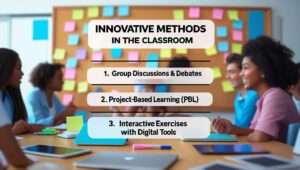Transforming the Classroom with Innovative Teaching Methods
Ever wondered how to make every student actively engaged in the classroom? The answer lies in innovative teaching methods—approaches that not only enhance learning experiences but also equip learners with critical thinking and real-world problem-solving skills.
Education isn’t just about delivering information anymore. Today’s classrooms demand student-centric, dynamic, and practical educational approaches that cater to a variety of learning styles and prepare students for future challenges. This blog will explore the importance, characteristics, and application of innovative teaching strategies in creating personalized, interactive, and effective learning environments.
Whether you’re exploring project-based learning, leveraging cutting-edge digital tools, or fostering collaborative learning, these strategies are for teachers who want to make an impact.
The Rise of Innovative Teaching Methods and How They Are Changing Education
Ever felt like traditional lectures didn’t capture your imagination—or your students’? We’ve all been there, sitting through conventional chalk-and-talk sessions that focus on theoretical knowledge and rote memorization with little room for excitement or real-world application. But education is making a shift, and innovative teaching methods are at the heart of this transformation.
This post dives into what makes these methods so effective, their benefits, and how educators like you can apply them to improve classroom engagement, critical thinking, academic outcomes, and more.
Here’s what you’ll learn:
- Why innovative teaching methods are essential
- Key characteristics of these approaches
- Practical strategies to create an interactive and engaging classroom
- The driving role of technology in transforming education
Why Innovative Teaching Methods Matter
Traditional teaching methods, while valuable, lack the flexibility and engagement necessary to meet the needs of modern learners. Innovative approaches shift the focus from passive information downloading to active learning—empowering students to think critically, work collaboratively, and solve problems effectively.
The Core Benefits:
- Enhanced Engagement – Interactive methods like gamification and experiential learning make education fun and relatable for students.
- Skill Development – Students acquire practical problem-solving skills and critical thinking abilities through real-world applications.
- Flexible Learning Styles – Each student is unique. By incorporating personalized learning experiences, tailored to individual strengths and weaknesses, no one feels left behind.
- Preparation for the Future – Beyond retaining knowledge, these methods equip students with interpersonal skills and adaptability, preparing them for a collaborative and tech-driven world.
Innovative teaching is more than upgrading lesson plans—it’s about embracing a growth mindset as an educator and continuously exploring new techniques to improve the learning experience.
What Defines Innovative Teaching Methods?
Great teaching isn’t about doing more; it’s about doing things differently. Below are the key characteristics of innovative teaching practices that make them effective.
1. Student Engagement is the Priority
Innovative teaching focuses on actively involving students in the learning process. This could mean leading discussions, solving puzzles, or completing group projects. When students participate instead of passively listening, they retain information better and develop stronger skills.
2. Real-World Applications
Educators use real-world scenarios that connect lessons to students’ daily lives. For instance, solving community issues during class fosters creativity and critical thinking while teaching practical application.
3. Flexible and Differentiated Instruction
One size doesn’t fit all. Through differentiated instruction, innovative strategies cater to individual needs, ensuring every student can thrive, regardless of prior preparation.
4. Technology-Driven Personalization
Innovative educational methods integrate adaptive tools like online platforms or AI software to provide tailored content, whether students prefer audio-visual materials, hands-on exercises, or interactive quizzes. These adaptive learning methods adjust based on student progress, encouraging better comprehension.
5. Collaborative and Social Learning
Using techniques like the jigsaw method and teamwork exercises, students sharpen their interpersonal and communication skills—a must-have for future leaders.
Implementation of Innovative Teaching Methods
Excited to implement these ideas but don’t know where to start? Here are actionable steps:
- Start Small
Begin by modifying a single lesson. Replace traditional practice questions with a group activity or use interactive activities to break away from the typical traditional teaching approach.
- Leverage Free Digital Resources
No hefty tech budget? No problem! Free tools like Kahoot (for quizzes) and Google Jamboard (for virtual collaboration) can power small but effective learning experiences.
- Collaborate With Stakeholders
Engage your colleagues in brainstorming instructional approaches or share resources. Together, you can create rich lesson plans tailored to a diverse student population.
- Evaluate and Improve Continuously
Seek real-time feedback from students to refine your teaching practices and adapt to their evolving needs.
Improved Student Engagement
Lack of classroom engagement is one of the biggest challenges in educational institutions today. Innovative teaching methods leverage engaging practices to counter this challenge while catering to distinct challenges like diverse student needs, limited resources, and sprawling class sizes.
Here’s how you can make engagement soar in your classroom:
1. Active Learning Strategies
Active learning is all about involving students directly in the learning process. Instead of simply listening, students participate in discussions, activities, and even problem-solving activities. This includes the use of open-ended questions, in-depth debates, and paired peer learning, all of which encourage critical thinking skills.
2. Interactive Lessons
Interactive lessons turn lessons from passive to participatory. Use tools like interactive whiteboards or multimedia resources to prompt discussions or set up collaborative projects where students actively solve problems. For instance, an interactive timeline in a history class can elevate the way students perceive historical topics.
3. Personalized Learning
Innovative techniques like adaptive learning technologies create supportive environments, adjusting learning materials to accommodate each student’s strengths and weaknesses. This keeps them connected to the educational journey while ensuring no one is left behind.
Actionable Tip: Build lesson plans around inclusive environments where constructive feedback allows students to reflect on their learning milestones.
Applying Innovative Methods in the Classroom

Wondering how to start implementing these strategies in your teaching? Here’s a breakdown of practical applications for innovative teaching.
Establishing a Collaborative, Interactive Learning Environment
- Group Discussions & Debates
Encourage students to articulate their own ideas and listen to others by guiding focused classroom discussions. These build critical thinking and confidence.
- Project-Based Learning (PBL)
Structure lessons around projects where students solve real problems—like building eco-friendly models or running mock businesses. PBL fosters experiential learning while nurturing skills like teamwork and time management.
- Interactive Exercises with Digital Tools
Use apps like Kahoot and Mentimeter for in-class quizzes or collaborative brainstorming. These digital platforms make lessons interactive and engaging.
Enhanced Learning Outcomes Through Innovation
The ultimate goal of innovation in education is improved learning outcomes. By introducing innovative pedagogy, educators can bridge the gap between classroom models and real-life scenarios, ensuring students are fully equipped for future challenges.
Here are tested methods to improve outcomes in your classroom:
1. Project-Based Learning (PBL)
PBL lets students identify and solve real-world challenges, like designing a solar-powered device in a physics class, or developing marketing strategies for startups. This helps them develop analytical skills, creativity, and effective communication skills that extend far beyond the classroom.
2. Flipped Classrooms
Why spend class time lecturing when students can watch pre-recorded lectures at home? A flipped classroom allows teachers to use valuable classroom hours for problem-solving activities, boosting deeper engagement and improving outcomes. Students tackle complex topics together, with the teacher there to guide their learning.
3. Technology Integration
Use technology like virtual reality (VR) or AI-based tools to create immersive learning experiences. Imagine a biology class where students dissect animals using virtual dissecting tables or explore celestial bodies in a VR-simulated science class. These participatory experiences link the material to tangible, relatable ideas.
Leveraging Technology for Transformation
Technology plays a pivotal role in reshaping how education is delivered. Below are just a few ways it enhances teaching strategies.
1. Virtual Reality (VR) for Experiential Learning
Imagine students exploring historical landmarks or conducting science experiments in a virtual environment! VR brings abstract concepts to life, giving students a hands-on experience without leaving the classroom.
Applications:
- History classes can recreate moments like walking through medieval castles.
- Biology students can explore cells in virtual 3D models.
2. Artificial Intelligence (AI) for Personalization
With platforms powered by AI, lesson plans can adapt in real-time based on student feedback, adjusting difficulty to match the learner’s pace.
Features include:
- Automated assessments for rapid grading and student insights.
- Tailored lessons that play to each student’s strengths while addressing gaps.
3. Online Learning Platforms for Flexibility
Hybrid models combining blended learning empower students to participate in lessons both in-person and remotely. Tools like Google Classroom or Zoom promote accessibility and around-the-clock engagement.
How Innovative Strategies Boost Engagement and Interaction
Building a truly dynamic educational experience isn’t just about technology. At its core, innovative teaching encourages interactivity and collaboration.
Examples of Interactive Strategies:
- Gamification: Turning lessons into challenges or rewards to amp up student motivation.
- Active Learning Stations: Rotating groups to complete different challenges encourages movement and variety.
- Role Playing: Asking students to step into different characters or historical figures is a fun way to apply knowledge and understand perspectives.
Building Critical Thinking Skills With Innovative Methods
Critical thinking has moved to the forefront as a key component of education. Students need to think dynamically, applying theoretical concepts to real-world scenarios to solve problems creatively. Innovative strategies foster that mindset.
1. Inquiry-Based Learning
Pose complex questions that require students to explore, hypothesize, and investigate solutions themselves. It’s an excellent way to encourage deeper engagement while promoting creative teaching methods aligned with active learning approaches.
2. Collaborative Learning Experiences
Encourage cooperative problem-solving through group tasks, where students refine both collaborative skills and soft skills like teamwork, adaptability, and communication. Whether it’s tackling a group coding project or brainstorming solutions to real-world problems, collaborative learning sparkles with energy.
Why Collaboration Matters:
Through collaborative learning exercises like peer teaching, students develop teamwork, negotiation, and interpersonal communication skills. These “soft” skills are often undervalued but are crucial for future success.
Common collaborative techniques include:
- Group Projects – Assign complex tasks requiring students to problem-solve together, producing results as a team.
- Peer Reviews – Students evaluate each other’s work, building critical analysis skills.
Education for the Future
Innovative teaching methods are more than a fleeting trend—they represent a transformative approach to education. By fostering engagement and building transferable skills, they prepare hundreds of thousands of students to thrive in real-world scenarios beyond the classroom.
Now’s the time to rethink pedagogy. Try adopting just one idea—such as flipped classrooms or project-based learning—and watch as it energizes your students and reinvents your teaching experience.
Final Thoughts
Innovative teaching methods redefine how education is delivered, making learning personalized, engaging, and impactful for students of all ages. By placing students at the center of the process, integrating modern digital tools, and creating collaborative environments, educators can transform their classrooms into spaces of growth, curiosity, and innovation.
The path of an educator is always evolving, and so should your teaching strategies. Start experimenting, take inspiration from the innovative ideas we’ve explored, and watch your classroom come alive with excitement and participation.
Still wondering how to apply these strategies to your class? Don’t worry—you don’t have to do it all alone. Connect with your fellow educators or explore online tools to keep evolving your approach to teaching.
